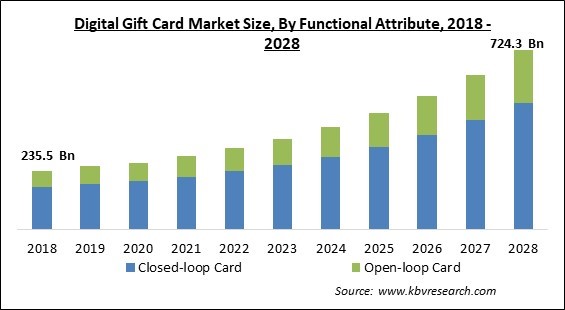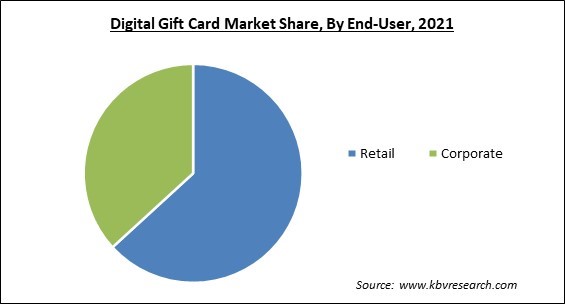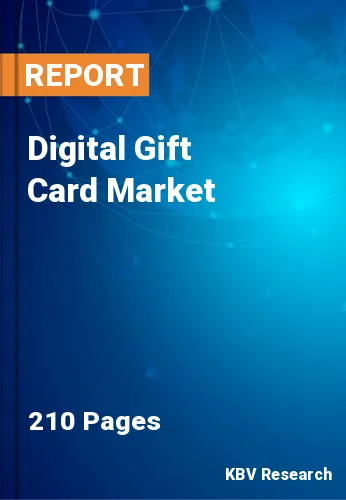The Global Digital Gift Card Market size is expected to reach $724.3 billion by 2028, rising at a market growth of 14.2% CAGR during the forecast period.
Gift cards may be used as payment at retail establishments, dining establishments, movie theatres, day spas, gas stations, and pretty much everywhere else you can buy goods or services. They are often bought by another person and presented as a gift for occasions like Christmas, birthdays, or even simply "a job well done."

Electronic gift cards, often known as digital gift cards, are available. Instead of being built from hard cardboard or plastic, they are created online. There are two types: closed loop cards, which can only be used at a certain retailer, like Woolworths, BWS, Big W, or standalone retail shops, and open loop cards, which may be used everywhere the brand of card is accepted. For example, a Visa gift card be utilized anywhere Visa is accepted.
The receiver is given a special digital code number rather than a physical card, which they may use to make transactions or make reservations. This is sent to their email. It may also be transmitted by text message or via apps on peoples' smartphones.
eGift cards may be used both online and offline, according to the retailer. You will often need to enter the code at Checkout if using it online. When making an in-store transaction, one must present eGift card on a digital device.
The main advantage of selling eGift cards for one's own company is that they are made to bring in new clients. eGift cards are often bought as gifts, as the name implies. They are often acquired by a returning customer who gives you the highest possible recommendation to their friends and relatives. This indicates that you are welcoming a variety of new buyers into your market.
Companies in the industry might develop and use near-field communication (NFC)-based gift cards on a greater scale as customers move toward contactless gift cards with scannable barcodes. Because of this, gift card solution providers would be better able to compete in the market. Additionally, during the pandemic, more individuals are making purchases using websites that provide these certificates. Digital gift cards have become more popular as a consequence of this. These factors will cause the market for digital gift cards to grow.
Gift cards are compared to prepaid debit cards in this regard. These cards are becoming increasingly widely used for payments by customers because of their ease, adaptability, dependability, and security. These cards are a crucial component of online payments. Gift cards generate 2% of worldwide e-commerce and 1% of the point of sale (POS) spending, according to Worldpay's 2018 report. This explosive growth in digital commerce, particularly on mobile devices, presents a chance for merchants and issuers to accept a rising number of new technologies which give their customers cutting-edge and seamless payment options.
One of the finest methods for businesses to generate money nowadays is via gift cards. Gift card firms may now generate more income thanks to ongoing technological advancements. Companies gain from these gift card developments because they make them more distinctive and appealing. Recent years have seen a rise in the demand for high-end items and technology developments related to payment solutions. The expansion of the digital gift card industry is driven by such extensive creative solutions that are centered on the customer experience.
However, many cards are store-specific, which means they are only accepted at certain merchants. This is OK if the receiver makes purchases there, but less so if she doesn't. Suppose a person buys a gift card and is unsure if the recipient, like a certain retailer, plays it safe and gets a Mastercard or Visa gift card. Since they can visit various businesses, closed-loop cards restrict the recipient's ability to make purchases. With all these cards, one must normally make purchases through the issuer. Any minor balance remaining on the card after purchases might be lost.
Based on the functional attribute, the digital gift card market is classified into open-loop gift cards and close-loop gift cards. With the largest revenue share in 2021, the close-loop gift card category led the digital gift card market. Gift cards with a closed loop only function at a single retailer or with the brands of a single company. It is a closed-loop gift card; for instance, "Sample Restaurant" sells gift cards with their name and emblem on them that can only be used at their eatery.

Based on end user, the digital gift card market is classified into retail and corporate. The corporate category significantly increased its sales shared in the digital gift card industry in 2021. This is due to an increase in business owners' awareness of the need to expose corrupt individuals to their representatives. Corporate gift cards have the advantage of promoting client loyalty. Earning clients' loyalty is crucial if you want them to continue with your business over time. And you can only keep them content and happy if you can gain their allegiance.
Based on application, the market is classified into Consumer goods, health & wellness, restaurants & bars, travel & tourism, media & entertainment, and others. Consumer goods held the highest revenue share in 2021 globally. Gift cards are often beneficial when used at a place of business that accepts credit cards for goods or services that the majority of consumers desire or need, such as an electronics shop that sells more expensive things that many customers wouldn't typically purchase. Gift cards entice customers to explore your establishment who would not have otherwise done so.
| Report Attribute | Details |
|---|---|
| Market size value in 2021 | USD 295.5 Billion |
| Market size forecast in 2028 | USD 724.3 Billion |
| Base Year | 2021 |
| Historical Period | 2018 to 2020 |
| Forecast Period | 2022 to 2028 |
| Revenue Growth Rate | CAGR of 14.2% from 2022 to 2028 |
| Number of Pages | 210 |
| Number of Tables | 359 |
| Report coverage | Market Trends, Revenue Estimation and Forecast, Segmentation Analysis, Regional and Country Breakdown, Companies Strategic Developments, Company Profiling |
| Segments covered | Functional Attribute, Application, End-user, Region |
| Country scope | US, Canada, Mexico, Germany, UK, France, Russia, Spain, Italy, China, Japan, India, South Korea, Singapore, Malaysia, Brazil, Argentina, UAE, Saudi Arabia, South Africa, Nigeria |
| Growth Drivers |
|
| Restraints |
|
Based on geography, the digital gift card market is analyzed across North America, Europe, Asia Pacific, and LAMEA. With the highest revenue share in 2021, the North American region dominated the digital gift card market. The most common kind of Christmas gift in the United States is a gift card, which is helping to fuel the nation's expanding gift card industry. Additionally, in recent years, the demand for gift cards has skyrocketed for special occasions like Christmas and birthdays, which has boosted market expansion.
Free Valuable Insights: Global Digital Gift Card Market size to reach USD 724.3 Billion by 2028
The market research report covers the analysis of key stake holders of the market. Key companies profiled in the report include Apple, Inc., Fiserv, Inc., PayPal Holdings, Inc., Walmart, Inc., Amazon.com, Inc., Target Corporation (Target Brands, Inc.), Loop Commerce, Inc (Synchrony Financial), InComm Payments, and Blackhawk Network Holdings, Inc.
By Functional Attribute
By End User
By Application
By Geography
The global Digital Gift Card Market size is expected to reach $724.3 billion by 2028.
Increase In Adoption Of Advanced Payment Solutions are driving the market in coming years, however, Few Cards Are Restricted To Usage In Particular Shops restraints the growth of the market.
Apple, Inc., Fiserv, Inc., PayPal Holdings, Inc., Walmart, Inc., Amazon.com, Inc., Target Corporation (Target Brands, Inc.), Loop Commerce, Inc (Synchrony Financial), InComm Payments, and Blackhawk Network Holdings, Inc.
The Retail segment is leading the Global Digital Gift Card Market by End-User in 2021 thereby, achieving a market value of $436.4 billion by 2028.
The North America market dominated the Global Digital Gift Card Market by Region in 2021, and would continue to be a dominant market till 2028; thereby, achieving a market value of $234 billion by 2028.
Our team of dedicated experts can provide you with attractive expansion opportunities for your business.

